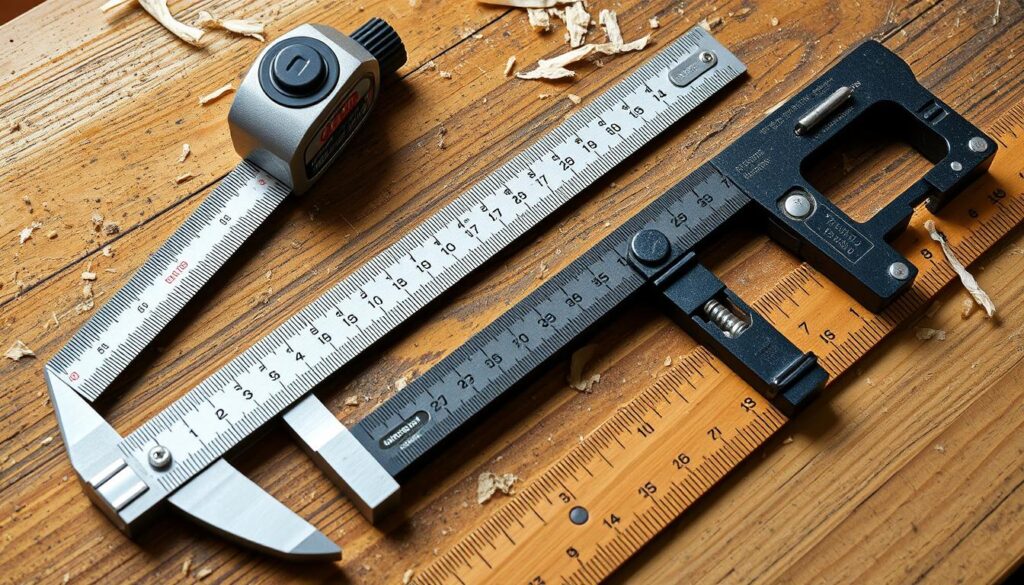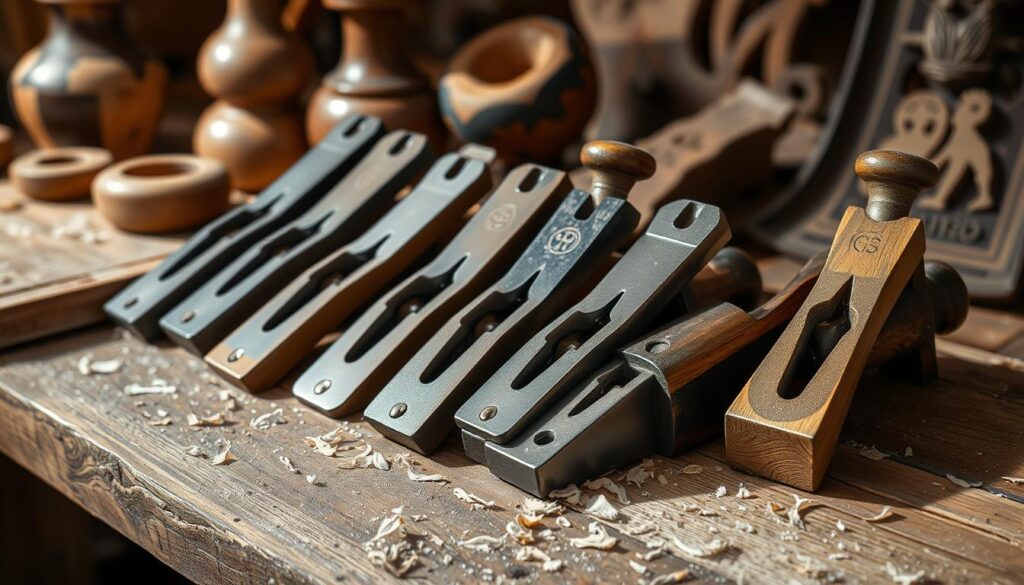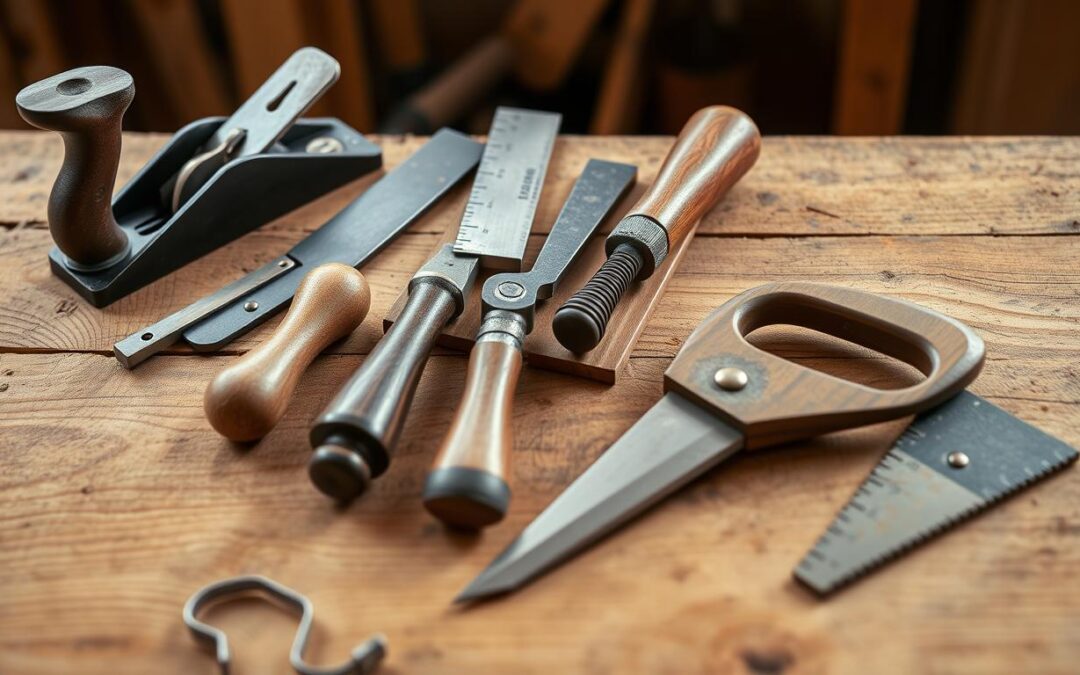Woodworking needs skill, patience, and the right tools. As a craftsman, your hand tools are key to your workshop. They help you shape, cut, and join wood with precision. Whether you’re new or experienced, good hand tools are vital for great results.
Starting woodworking means building a solid tool collection. You’ll need chisels, hand planes, and more. Each tool is crucial for bringing your ideas to life. Learning to use these tools deeply connects you to your craft.
Right hand tools make your work better and your experience richer. They let you feel the wood, make fine adjustments, and work quietly. With practice, your tools become part of you, showing off your true skill.
Key Takeaways
- Quality hand tools are essential for precision in woodworking
- Invest in versatile tools suitable for various projects
- Hand tools offer better control and connection with the wood
- Building a tool collection gradually improves skills over time
- Mastering hand tools enhances overall craftsmanship
- Hand tools work quietly and don’t require electricity
Introduction to Woodworking Hand Tools
Woodworking is a craft that needs the right tools. Quality hand tools are key for precision and control. Let’s dive into the world of woodworking hand tools and why they’re vital for all woodworkers.
The importance of quality hand tools in woodworking
Quality hand tools are the heart of woodworking. They let you feel the wood, make precise cuts, and add fine details. Investing in top-notch tools means better results and longer tool life. A well-made chisel or plane can last forever with the right care.
Benefits of hand tools over power tools
Hand tools have unique benefits over power tools:
- Greater control and precision
- Less noise and dust
- No need for electricity
- Safer for beginners
- Better for delicate or small-scale work
Building your hand tool collection gradually
Begin with the basics and grow your collection as you improve. Here’s a guide for getting woodworking hand tools:
| Priority | Tool Type | Examples |
|---|---|---|
| 1 | Measuring and Marking | Tape measure, square, pencils |
| 2 | Cutting | Hand saw, chisels |
| 3 | Shaping | Planes, rasps |
| 4 | Joinery | Mallet, clamps |
It’s not about having every tool. It’s about having the right tools for your projects. Quality hand tools will be your best friends in woodworking.
Essential Cutting Tools for Woodworking
Cutting tools are key for woodworkers. They help shape and refine wood into stunning pieces. Let’s look at the most important tools you’ll need.
Chisels: Types and Uses
Chisels are versatile tools with different shapes and sizes. Bench chisels are great for general tasks. Mortise chisels are perfect for precise joints. Paring chisels are best for fine details.
Hand Saws: Choosing the Right Saw for Your Project
Hand saws are crucial for cutting wood. Rip saws cut with the grain, and crosscut saws cut across it. For curves, use a coping saw. For precise cuts, a Japanese pull saw is the best.
- Rip saw: For cutting with the wood grain
- Crosscut saw: For cutting across the wood grain
- Coping saw: For cutting curves and intricate shapes
- Japanese pull saw: For ultra-precise cuts
Planes: Smoothing and Shaping Wood Surfaces
Planes are vital for smooth wood surfaces. A jack plane is versatile, while a smoothing plane gives a glass-like finish. For edges, use a block plane.
“The plane is the most fundamental tool in woodworking. Master it, and you’ve mastered half the craft.”
Knowing these tools will prepare you for many woodworking projects. Always keep your tools sharp for the best results and safety.
Measuring and Marking Tools
Accurate measuring and marking are key in woodworking. The right tools ensure your projects turn out well. Here are some essential tools every woodworker needs.

A tape measure is essential for any woodworking task. It makes quick and easy length measurements. For precise small measurements, a steel ruler is better. Calipers are great for measuring thickness and diameter accurately.
For marking, a pencil is basic but a marking knife is better for fine lines. It makes cutting easier. A marking gauge is great for making straight lines, important for joining pieces.
Squares are crucial in woodworking. They ensure your cuts and joints are right angles. A combination square is versatile, checking angles and depths.
| Tool | Primary Use | Accuracy Level |
|---|---|---|
| Tape Measure | Long measurements | Medium |
| Steel Ruler | Short, precise measurements | High |
| Calipers | Thickness and diameter | Very High |
| Marking Knife | Fine line marking | Very High |
| Marking Gauge | Parallel line marking | High |
| Combination Square | Angle checking and marking | High |
The quality of your measuring and marking tools affects your woodworking. Invest in good tools and keep them in good condition for the best results.
Shaping and Carving Tools
Woodworking projects need precise shaping and detailed carving. Let’s look at the key tools for these tasks.
Spokeshaves: Curved Surface Specialists
Spokeshaves are great for curved surfaces. They have a sharp blade in a body with handles on each side. You can adjust the blade depth for precise wood removal.
They’re ideal for making chair legs, boat hulls, and other rounded shapes.

Carving Tools: Gouges, V-tools, and Knives
Carving tools help you make detailed designs and textures in wood. Gouges have curved blades for scooping out material. V-tools make sharp, angular cuts. Carving knives are versatile for general shaping.
Choose carving tools based on the projects you do most often.
Rasps and Files: Refining Wood Shapes
Rasps and files smooth and refine wood surfaces after initial shaping. Rasps have coarse teeth for removing a lot of material. Files have finer teeth for finer work.
Both tools come in various shapes for different contours. Use rasps for rough shaping, then files for the final smooth touch.
| Tool | Best Use | Skill Level |
|---|---|---|
| Spokeshaves | Curved surfaces | Intermediate |
| Carving tools | Detailed designs | Advanced |
| Rasps and files | Surface refinement | Beginner to Intermediate |
Mastering these tools opens up new possibilities in woodworking. Practice with each tool to improve your skills. This way, you can create more refined and artistic pieces.
Woodworking Hand Tools for Joinery
Joinery tools are key in woodworking. They help make strong, precise joints for furniture and more. Let’s look at some essential joinery tools every woodworker needs.
Mallets are vital for joinery. They give softer blows than hammers, which is better for your tools and work. Wooden mallets are especially good for delicate work.
Mortise chisels are a must for joinery. They have thick blades for heavy chopping. This is needed for tight-fitting mortise and tenon joints, important in furniture making.
Marking gauges are precise tools for scribing lines. They help lay out joinery cuts accurately. A good marking gauge ensures your joints fit well, making your projects stronger and look better.
- Dovetail saws: Fine-toothed saws for cutting precise angles in dovetail joints
- Combination squares: Versatile tools for marking and checking 90-degree and 45-degree angles
- Shoulder planes: Small planes for trimming tenon shoulders and other joint surfaces
Quality joinery tools improve your woodworking skills. They help you make joints that last. Remember, practice is key to mastering joinery techniques.
Clamping and Holding Tools
Securing your workpiece is key for precise and safe woodworking. Let’s look at the essential tools that keep your projects steady.
Types of Woodworking Clamps
Woodworking clamps come in many shapes and sizes. Each is made for different tasks. Bar clamps are versatile for big projects. Spring clamps work fast for light tasks.
C-clamps apply focused pressure well. Pipe clamps are great for long glue-ups.
Vises and Bench Dogs
Vises are crucial for holding work to your bench. A front vise grips boards for edge work. An end vise with bench dogs secures long pieces.
Bench dogs are pegs that fit into holes on your bench. They create a sturdy clamping surface with a vise.
Importance of Proper Clamping Techniques
Learning clamping techniques is vital. It keeps your work in place and prevents damage. Always use protective pads to avoid marring your workpiece.
Apply even pressure and check for square when clamping assemblies. For edge gluing, alternate clamps on top and bottom to prevent bowing.
| Tool | Best Use | Key Feature |
|---|---|---|
| Bar Clamps | Large assemblies | Adjustable length |
| C-Clamps | Focused pressure | Strong grip |
| Vises | Bench-mounted work | Stable holding power |
| Bench Dogs | Long workpieces | Works with vises |
Conclusion
Woodworking hand tools are key for any craftsman. Investing in quality tools sets you up for success. Start with the basics and add more as you grow.
Each tool, from chisels to saws, is vital for your projects. As you use them, you’ll connect more with the wood. You’ll also get better at woodworking.
Hand tool woodworking is an art that grows your skills. With patience and hard work, you’ll master old techniques. Your workshop is ready – pick up your tools and let your creativity fly!
FAQ
What are the must-have woodworking hand tools for beginners?
Beginners need a set of chisels, a hand saw, and a block plane. Also, a combination square, a marking gauge, and clamps are key. These tools help with basic tasks like cutting, shaping, and measuring.
Why are quality hand tools important in woodworking?
Quality hand tools are vital because they offer precision and control. They help make cuts more accurate and surfaces smoother. This leads to better craftsmanship and projects that last longer.
What are the benefits of using hand tools over power tools?
Hand tools give you more control and are quieter. They also let you work more slowly and thoughtfully. This approach helps you understand woodworking better.
How can I build a comprehensive collection of woodworking hand tools?
Start with the basics and add more as you grow. Choose tools that are durable and will last. You can also find good deals on used tools from trusted sources.
What are the different types of chisels and their uses?
There are bench chisels for general work, mortise chisels for precise cuts, and paring chisels for fine details. Chisels are key for chopping, paring, and cleaning up joints.
How do I choose the right hand saw for my woodworking project?
Choose a saw based on the cuts you need to make and the material’s thickness. Rip saws are for cutting with the grain, while crosscut saws are for across. Look at the blade’s shape, tooth count, and handle when picking a saw.
What is the purpose of a spokeshave in woodworking?
A spokeshave is for shaping and smoothing curved surfaces. It’s used for chair rungs, tool handles, and other turned pieces. Its design lets you control the shape of both concave and convex surfaces.
What are the essential measuring and marking tools for woodworking?
You’ll need a tape measure, a combination square, a marking gauge, and a pencil or knife. These tools help with accurate measurements, straight edges, and precise markings.
How important is clamping in woodworking, and what types of clamps are commonly used?
Clamping is crucial for holding workpieces during various woodworking steps. Common clamps include F-style, bar, pipe, and corner clamps. Using the right clamps ensures your work is accurate and safe.

